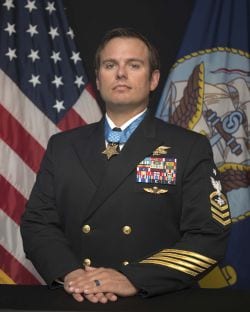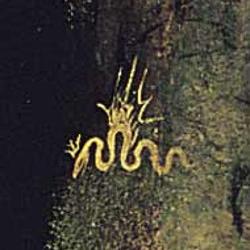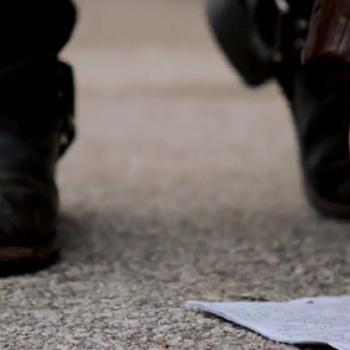The purpose of every vocation is to love and serve your neighbor. Being in the military is a vocation. Notice how the vocational concept of “serving” is part of the very language of the military and of Veterans Day: “Military service.” “The military services are the Army, Navy, Marines, Air Force, and Coast Guard.” “I served in the army.” “You veterans served your country.” “Thank you for your service.”
On this Veterans Day (which does not take an apostrophe) and in honor of all military veterans, I urge you to read these citations of recent recipients of the Congressional Medal of Honor. Note the themes of vocation, such as doing one’s duty and self-sacrifice for one’s neighbor.
Edward C. Byers, Jr.
Chief, U.S. Navy Born: August 4, 1979, Toledo, Ohio Place / Date: Qarghah’i District of Laghman, Afghanistan, December 8-9, 2012
Citation
For conspicuous gallantry and intrepidity at the risk of his life above and beyond the call of duty as a Hostage Rescue Force Team Member in Afghanistan in support of Operation Enduring Freedom from 8 to 9 December 2012. As the rescue force approached the target building, an enemy sentry detected them and darted inside to alert his fellow captors. The sentry quickly reemerged, and the lead assaulter attempted to neutralize him. Chief Byers with his team sprinted to the door of the target building. As the primary breacher, Chief Byers stood in the doorway fully exposed to enemy fire while ripping down six layers of heavy blankets fastened to the inside ceiling and walls to clear a path for the rescue force. The first assaulter pushed his way through the blankets, and was mortally wounded by enemy small arms fire from within. Chief Byers, completely aware of the imminent threat, fearlessly rushed into the room and engaged an enemy guard aiming an AK- 47 at him. He then tackled another adult male who had darted towards the corner of the room. During the ensuing hand-to-hand struggle, Chief Byers confirmed the man was not the hostage and engaged him. As other rescue team members called out to the hostage, Chief Byers heard a voice respond in English and raced toward it. He jumped atop the American hostage and shielded him from the high volume of fire within the small room. While covering the hostage with his body, Chief Byers immobilized another guard with his bare hands, and restrained the guard until a teammate could eliminate him. His bold and decisive actions under fire saved the lives of the hostage and several of his teammates. By his undaunted courage, intrepid fighting spirit, and unwavering devotion to duty in the face of near certain death, Chief Petty Officer Byers reflected great credit upon himself and upheld the highest traditions of the United States Naval Service.
Florent A. Groberg
Captain, U.S. Army 4th Infantry Brigade Combat Team, 4th Infantry Division Born: 8 May 1983, Poissy, France Place / Date: Asadabad, Kunar Province, Afghanistan, 8 August 2012
Citation
Captain Florent A. Groberg distinguished himself by acts of gallantry and intrepidity at the risk of his life above and beyond the call of duty while serving as a Personal Security Detachment Commander for Task Force Mountain Warrior, 4th Infantry Brigade Combat Team, 4th Infantry Division, during combat operations against an armed enemy in Asadbad, Kunar Province, Afghanistan on August 8, 2012. On that day, Captain Groberg was leading a dismounted movement consisting of several senior leaders to include two brigade commanders, two battalion commanders, two command sergeants major, and an Afghanistan National Army brigade commander. As they approached the Provincial Governor’s compound, Captain Groberg observed an individual walking close to the formation. When the individual made an abrupt turn towards the formation, he noticed an abnormal bulge underneath the individual’s clothing. Selflessly placing himself in front of one of the brigade commanders, Captain Groberg rushed forward, using his body to push the suspect away from the formation. Simultaneously, he ordered another member of the security detail to assist with removing the suspect. At this time, Captain Groberg confirmed the bulge was a suicide vest and with complete disregard for his life, Captain Groberg again with the assistance of the other member of the security detail, physically pushed the suicide bomber away from the formation. Upon falling, the suicide bomber detonated his explosive vest outside the perimeter of the formation, killing four members of the formation and wounding numerous others. The blast from the first suicide bomber caused the suicide vest of a previously unnoticed second suicide bomber to detonate prematurely with minimal impact on the formation. Captain Groberg’s immediate actions to push the first suicide bomber away from the formation significantly minimized the impact of the coordinated suicide bombers’ attack on the formation, saving the lives of his comrades and several senior leaders. Captain Groberg’s extraordinary heroism and selflessness above and beyond the call of duty at the risk of life are in keeping with the highest traditions of military service and reflect credit upon himself, 4th Infantry Brigade Combat Team, 4th Infantry Division and the United States Army.
UPDATE: Captain Groberg did survive the blast, though he was seriously injured. According to Wikipedia, after dragging the man with the suicide vest away from the formation, the explosion threw him nearly 20 feet. He lost nearly half of his left calf muscle, blew out an eardrum, suffered a brain injury, and sustained serious nerve damage.
[Keep reading for posthumous awards for service in the Civil War and World War I. . . ]
Illustration by Circe Denyer, CC0, Public Domain via PublicDomainPictures.net















